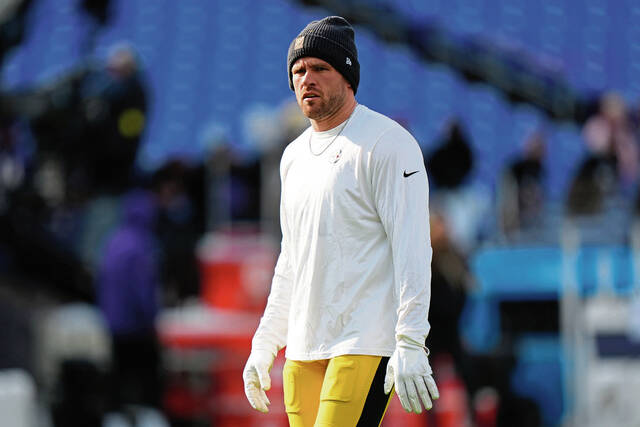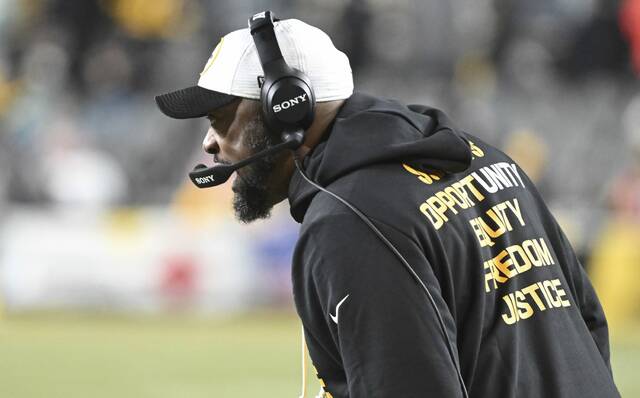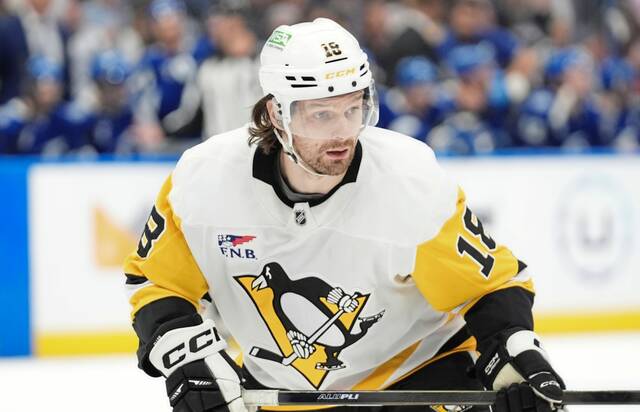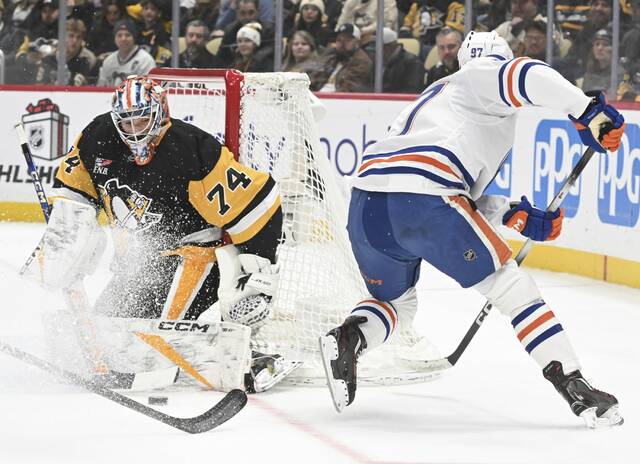There isn’t a lot of mystery to Bryan Rust’s game these days.
He skates fast, forechecks like a badger, goes to the net without a molecule of hesitation and isn’t shy about shooting the puck.
And he almost exclusively plays on the right wing, typically on the top line with Sidney Crosby.
That latter quality wasn’t always the case as earlier in his career, Rust would be used on both wings and all three lines.
“That’s important throughout the (season),” Rust said in Cranberry on Oct. 18. “Guys need to step in at center or move over to the wing and play through injuries. It gives more options.”
The Penguins’ roster has plenty of options with regard to forwards who can play multiple positions at the moment.
In addition to Rust, forwards Noel Acciari, Anthony Beauvillier, Cody Glass, Kevin Hayes, Drew O’Connor and Rickard Rakell all have substantial experience playing multiple positions.
Additionally, Blake Lizotte is expected to transition to a winger role once he recovers from a concussion he suffered during the preseason while Matt Nieto, currently designated to long-term injured reserve following offseason surgery on his left knee, has logged considerable minutes on both wings throughout his career.
There are no hard statistics on how many versatile forwards the Penguins have had over the years. And they’ve certainly had some notable players with malleability such as Matt Cullen, Eric Fehr and Jussi Jokinen.
But it’s seemingly rare to have this many on the roster at one time.
“Generally, you kind of play a little bit of everywhere growing up,” said Beauvillier, who lined up at all three forward positions while playing for three different teams last season. “It’s good to have just to be able to play everywhere. You can move up and down the lineup. Growing up, I feel like I’ve played everywhere. It definitely helps me out.”
Coming out of the NCAA ranks with Boston College, Hayes was primarily a winger but picked up the duties of center in something of an organic manner as a rookie with the New York Rangers in 2014-15.
“I looked with my family and agent and penciled myself in on a wing position to make the team out of camp,” Hayes said. “I was hoping that was going to be my spot that I was going to get. Stuff happened. Injuries happened. I slid into center. I’ve played center pretty much my whole (professional) career. With injuries sometimes in the top-six (forwards), I sometimes get pushed up there on the wing throughout my career. (Philadelphia Flyers coach John Tortorella) pushed me to the wing for a little bit.”
Acciari predominantly served as the Penguins’ fourth-line center for most of 2023-24 and even took the fourth-most faceoffs on the squad. This season, he has largely been deployed as a right winger on the fourth line due to the team’s surplus of forwards who are primarily centers.
“Wing, you’ve got a little bit more freedom to do some stuff,” Acciari said. “When I play center, I’m a little bit more defensive-minded. I’ll make sure the puck gets out. Make sure before I leave the (defensive) zone, the puck is out. I take pride in not getting scored on. When I’m center, that’s my mentality. With wing, I have a little more freedom to blow the zone and just anticipate a puck to get out.”
Glass learned the value of versatility at the junior level. Former Penguins coach Mike Johnston imbued that lesson when he was was Glass’ coach with the Western Hockey League’s Portland Winterhawks.
“Find ice time anywhere you can,” Glass said. “Be good at something. As a 16-year-old, I (penalty killed) and I also played wing. And I was naturally a center and was always on the power play. But when you come in as a young guy, sometimes the power play is taken, so you have to find a way to be good and trustworthy to your coaches. You have to find different ways of doing that.”
That versatility has been on display quite a bit with the Penguins’ fourth line which has predominately been composed of Acciari, Glass and Hayes.
“We’re all centers,” Acciari said. “We can all play wing. We can interchange whenever. It makes things easier. We’re not trying to get back to our positions. It doesn’t matter what side the faceoff is, all three of us can take it.”
Versatility such as that can make it easier for a player to stay in the lineup.
“Always been kind of a Swiss Army knife,” Glass said. “It’s always good to have in your back pocket. You never know, somebody might go down somewhere and you fit right in. It’s a good quality to have.”








